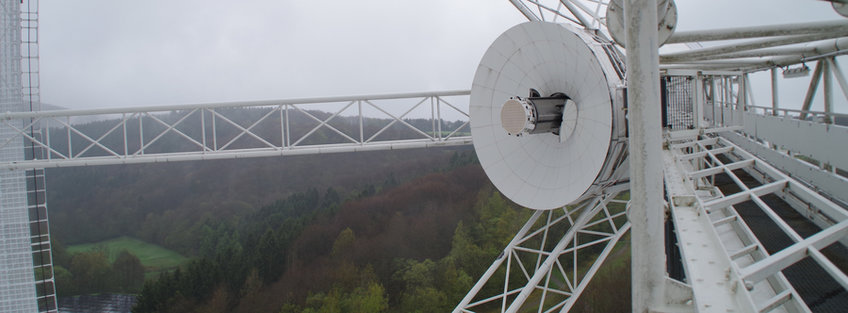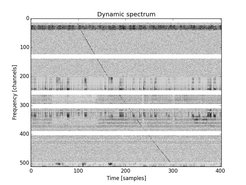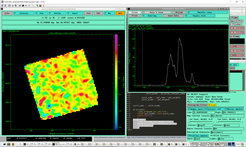
PAF - Phased Array Feed Receiver
A PAF receiver is a dense array of antenna elements at the focus of a reflector telescope and the output of these elements can be combined to form beams on the sky. The direction of these beams is controlled by varying the weighting of individual elements of the PAF. The PAF system described here was designed for the Australian Square Kilometer Array Pathfinder (ASKAP) telescope, but slightly modified for use on the Effelsberg telescope. As there is more radio-frequency interference (RFI) at Effelsberg than at the ASKAP site, we used narrower bandpass filters in the PAF to reject interference from mobile phones and lower-frequency digital television services. The PAF system used at Effelsberg was optimised to cover the quieter 1.2 GHz to 1.74 GHz band with two frequency bands covering 1.2 GHz to 1.48 GHz and 1.34 GHz to 1.74 GHz. The image above shows the PAF receiver installed at the primary focus of the Effelsberg 100-m radio telescope (credit, Reinhard Keller, MPIfR).
An array of 188 connected “chequerboard” antenna elements is distributed over approximately a 1.2m diameter circle. It is a dual-polarization receiver and each polarization has 94 elements. The analog signals from all elements, each of up to 600 MHz bandwidth, are transmitted to the digital receiver via RF-over-fiber links and sampled there by 12 “Dragonfly” digital receivers. The digital receivers also channelise the data to 1 MHz via a multi-stage oversampled filterbank. With 16 ports per receiver this results in a 192 port digital system, with four spare ports beyond the 188 connected to the PAF. The digitised signals are processed by eight “Redback'” beamformers to form up to 36 dual-polarisation beams of 384 MHz bandwidth (48 MHz per beamformer) in 1 MHz frequency channels. We stream 336 MHz of 16 bit beamformed baseband data (42 MHz per beamformer) at the full sampling rate into Graphics Processing Unit (GPU) nodes via Ethernet switches in 7-MHz frequency chunks.
We have two science modes for the receiver, which are search mode and spectroscopy mode. Search mode was developed to search single pulses from Fast-Radio-Bursts (FRBs) and strong pulsars. Spectroscopy mode provides high-frequency resolution (~1.16KHz) data in IQUV (Stokes parameters) and AABB for map and spectroscopy. The search mode also produces high-frequency resolution data in IQUV and AABB of sub-band for simultaneous spectroscopy. We also have software ready for fold mode, which can be used to observe and fold known pulsars in real-time. All modes generate IQUV and AABB with coarse channels for monitor purpose. All modes are capable to process 4 beams on one GPU server, with 9 GPU servers at Effelsberg, we can process all 36 PAF beams.



